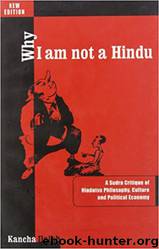Why I Am Not a Hindu by Kancha Illaiah

Author:Kancha Illaiah [Illaiah, Kancha]
Language: eng
Format: epub
ISBN: 9788185604824
Google: lA4EPQAACAAJ
Amazon: 8185604827
Publisher: Samya
Published: 2005-01-01T18:30:00+00:00
CHAPTER V
Hindu Gods and Us: Our Goddesses and the Hindus
What is the relationship between the Hindu Gods and ourselves? Did the Hindu brahminical Gods treat us as part of their people, or even as legitimate devotees? Why did Hinduism create the images of many Gods as against the universal ethic of monotheism? Did brahminical polytheism work in the interest of Dalitbahujan masses or did it work in the interest of brahminical forces who are a small minority? Further, what is the relationship between the Dailtbahujan Goddesses and Gods and the Hindus? Did the Hindus respect these deities or worship them? What are the socioeconomic and cultural forms of the Dalitbahujan Goddesses and Gods? Since the majority of the people relate to the Dalitbahujan Goddesses and Gods, isn't there a need to present their narratives? I shall discuss all these aspects in this chapter.
Hinduism has a socioeconomic and cultural design that manipulates the consciousness of the Dalitbahujans systematically. It has created several institutions to sustain the hegemony of the brahminical forces. Through the ages it has done this by two methods: (/') creating a consent system which it maintains through various images of Gods and Goddesses, some of whom have been co-opted from the social base that it wanted to exploit; and (li) when such a consent failed or lost its grip on the masses, it took recourse to violence. In fact, violence has been Hinduism's principal mechanism of control. That is the reason why many of the Hindu Gods were weapon-wielders in distinct contrast to the Gods of all other religions. No religion in the world has created such a variety of Gods who use both consent and violence to force the masses into submission. Thus, the relationship between the Hindu Gods and the Dalitbahujans has been that of the oppressor and oppressed, the manipulator and the manipulated. Of course, one of the 'merits' of Hinduism has been that it addressed both the mind and the body of the oppressed.
Brahminical theoreticians have constructed their own theory of consciousness with a specific notion that the majority (bahujan) consciousness is confined to one specific activity and that that consciousness has to be constantly monitored in order to arrest its further growth. If a consciousness is manipulated to become and remain the slave of another consciousness, some day or the other it will rebel. These revolts are mostly suppressed. All religions have worked out strategies to manipulate and contain such revolts by teaching the slaves a so-called divine morality. But no religion has succeeded in suppressing the slaves for ever.
Other religions admitted slaves into their fold, although they suppressed them in the political and economic domains. But the Dalitbahujans never became part of Hinduism.
Hinduism differs from other religions even in terms of the way it has structured its Gods and Goddesses. All the Gods and Goddesses are institutionalized, modified and contextualized in a most brazen anti-Dalitbahujan mode. Hinduism has been claiming that the Dalitbahujans are Hindus, but at the same time their very Gods are openly against them.
Download
This site does not store any files on its server. We only index and link to content provided by other sites. Please contact the content providers to delete copyright contents if any and email us, we'll remove relevant links or contents immediately.
Fingersmith by Sarah Waters(2489)
Kundalini by Gopi Krishna(2138)
Wheels of Life by Anodea Judith(2098)
Indian Mythology by Devdutt Pattanaik(1903)
The Bhagavad Gita by Bibek Debroy(1901)
The Yoga of Jesus: Understanding the Hidden Teachings of the Gospels by Paramahansa Yogananda(1807)
Autobiography of a Yogi (Complete Edition) by Yogananda Paramahansa(1778)
The Man from the Egg by Sudha Murty(1749)
The Book of Secrets: 112 Meditations to Discover the Mystery Within by Osho(1633)
Chakra Mantra Magick by Kadmon Baal(1618)
The Sparsholt Affair by Alan Hollinghurst(1548)
Sparks of Divinity by B. K. S. Iyengar(1496)
Avatar of Night by Tal Brooke(1492)
Gandhi by Ramachandra Guha(1488)
Karma-Yoga and Bhakti-Yoga by Swami Vivekananda(1470)
The Bhagavad Gita (Classics of Indian Spirituality) by Eknath Easwaran(1456)
The Spiritual Teaching of Ramana Maharshi by Ramana Maharshi(1407)
Hinduism: A Very Short Introduction (Very Short Introductions) by Knott Kim(1348)
Skanda Purana (Great Epics of India: Puranas Book 13) by Bibek Debroy & Dipavali Debroy(1346)
